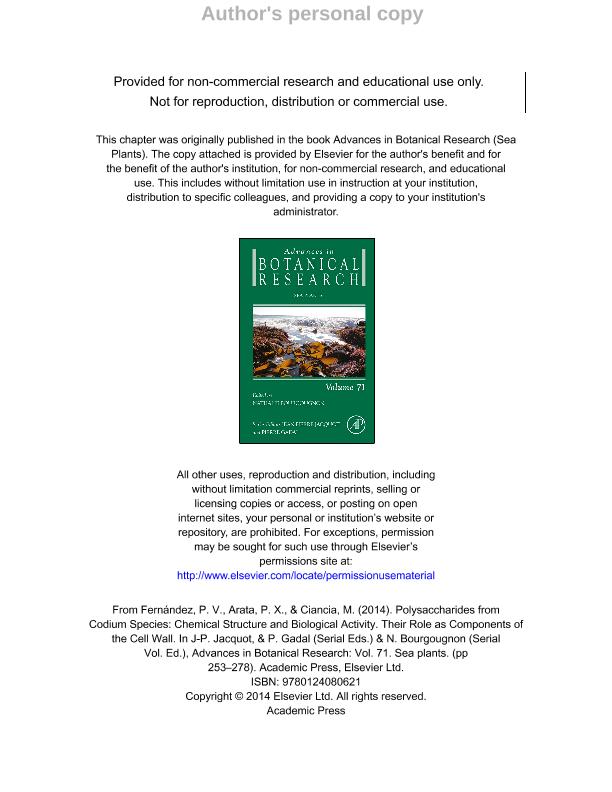Mostrar el registro sencillo del ítem
dc.contributor.author
Fernández, Paula Virginia

dc.contributor.author
Arata, Paula Ximena
dc.contributor.author
Ciancia, Marina

dc.date.available
2016-11-14T14:30:16Z
dc.date.issued
2014-05
dc.identifier.citation
Fernández, Paula Virginia; Arata, Paula Ximena; Ciancia, Marina; Polysaccharides from Codium species: chemical structure and biological activity. Their role as components of the cell wall; Elsevier; Advances In Botanical Research; 71; 5-2014; 253-278
dc.identifier.issn
0065-2296
dc.identifier.uri
http://hdl.handle.net/11336/8173
dc.description.abstract
Polysaccharides from Codium species have drawn attention due to their high anticoagulant activity. However, many different mechanisms of action have been proposed and the structure of the active compounds was usually not elucidated. Recently, structural determination has been carried out using purified fractions showing the presence of at least three different polysaccharide types, namely: (1) 3-linked B-D-galactans with ramifications on C-6 and terminal B-D-galactopyranose units with pyruvic acid ketal linked to O-3 and O-4 (S-configuration). Sulphation occurs mainly on C-4 and some of the 3-linked galactose units are substituted by pyruvic acid ketals linked to O-4 and O-6 (R-isomer). (2) 3-linked linear pyranosic B-L-arabinans sulphated on C-2 and/or C-4. (3) 4-linked B-D-mannans, partially sulphated on C-2 or on C-6, but to a lesser extent. The backbone of this polysaccharide is similar to that of the fibrillar component of the cell wall. Antiherpetic activity and activity on the immune system were determined for sulphated galactans from Codium fragile, which do not have significant anticoagulant effect, while highly sulphated arabinans have an important anticoagulant activity by mechanisms different to those described for heparin. The utricle cell wall of C. fragile has a sandwich structure of two fibrillar-like layers delimiting a middle amorphouslike zone. Mannans and hydroxyproline-rich glycoprotein-like epitopes are located in two distinct cell-wall layers, whereas sulphated polysaccharides are distributed in the middle area of the wall. The overall cell-wall polymer arrangement in the utricles of different species proved to be somewhat different.
dc.format
application/pdf
dc.language.iso
eng
dc.publisher
Elsevier

dc.rights
info:eu-repo/semantics/openAccess
dc.rights.uri
https://creativecommons.org/licenses/by-nc-nd/2.5/ar/
dc.subject
Bioactive Compound
dc.subject
Bryopsidales
dc.subject
Cell Wall
dc.subject
Codium
dc.subject
Green Seaweed
dc.subject
Sulphated Polysaccharide
dc.subject.classification
Bioquímica y Biología Molecular

dc.subject.classification
Ciencias Biológicas

dc.subject.classification
CIENCIAS NATURALES Y EXACTAS

dc.title
Polysaccharides from Codium species: chemical structure and biological activity. Their role as components of the cell wall
dc.type
info:eu-repo/semantics/article
dc.type
info:ar-repo/semantics/artículo
dc.type
info:eu-repo/semantics/publishedVersion
dc.date.updated
2016-11-11T16:51:11Z
dc.journal.volume
71
dc.journal.pagination
253-278
dc.journal.pais
Países Bajos

dc.journal.ciudad
Amsterdam
dc.description.fil
Fil: Fernández, Paula Virginia. Universidad de Buenos Aires. Facultad de Agronomia. Departamento de Biologia Aplicada y Alimentos; Argentina
dc.description.fil
Fil: Arata, Paula Ximena. Universidad de Buenos Aires. Facultad de Agronomia. Departamento de Biologia Aplicada y Alimentos; Argentina
dc.description.fil
Fil: Ciancia, Marina. Consejo Nacional de Investigaciones Científicas y Técnicas. Oficina de Coordinación Administrativa Ciudad Universitaria. Centro de Investigaciones en Hidratos de Carbono; Argentina. Universidad de Buenos Aires. Facultad de Agronomia. Departamento de Biologia Aplicada y Alimentos; Argentina
dc.journal.title
Advances In Botanical Research

dc.relation.alternativeid
info:eu-repo/semantics/altIdentifier/url/http://www.sciencedirect.com/science/article/pii/B9780124080621000093
dc.relation.alternativeid
info:eu-repo/semantics/altIdentifier/doi/http://dx.doi.org/10.1016/B978-0-12-408062-1.00009-3
Archivos asociados
